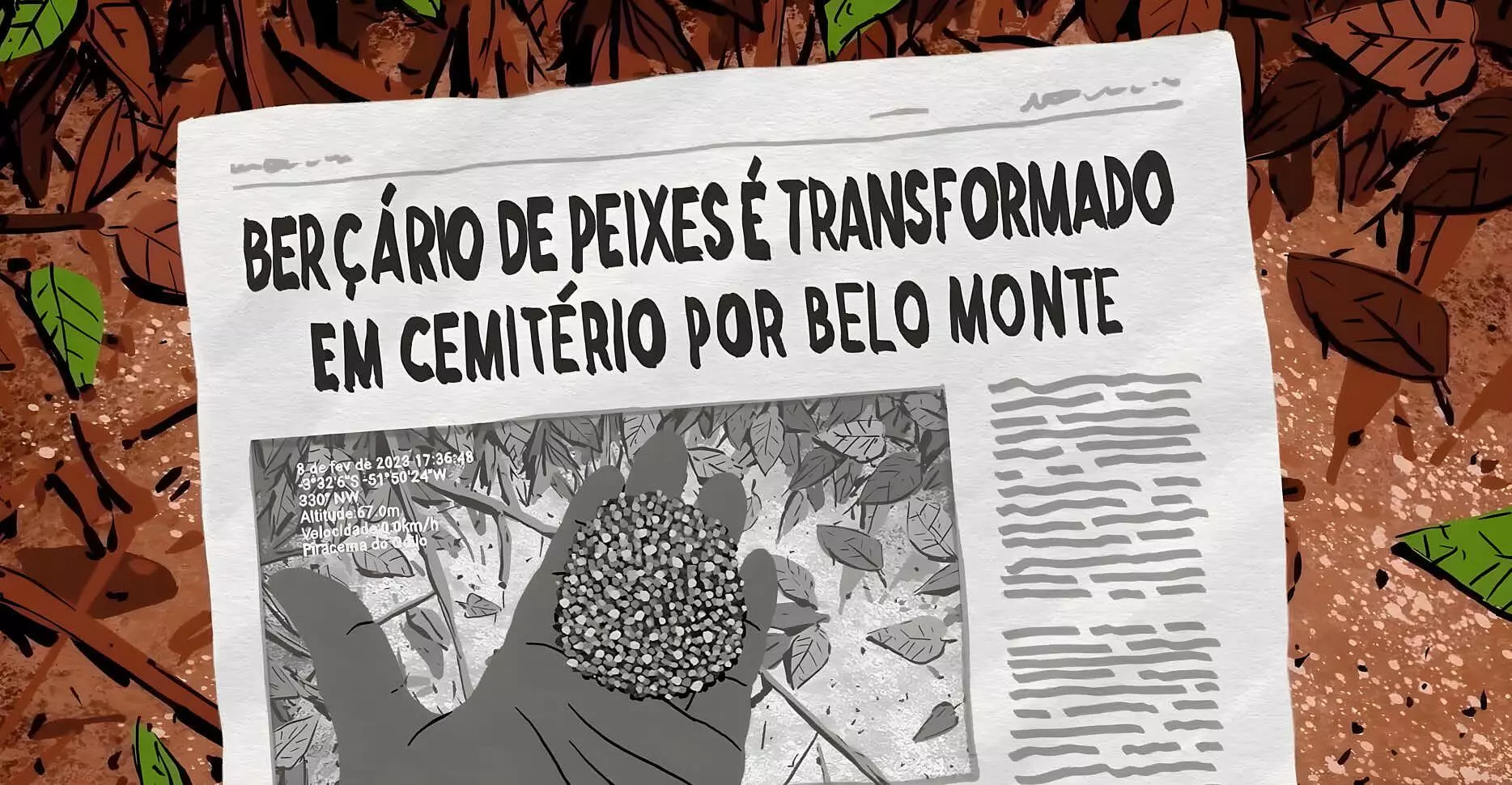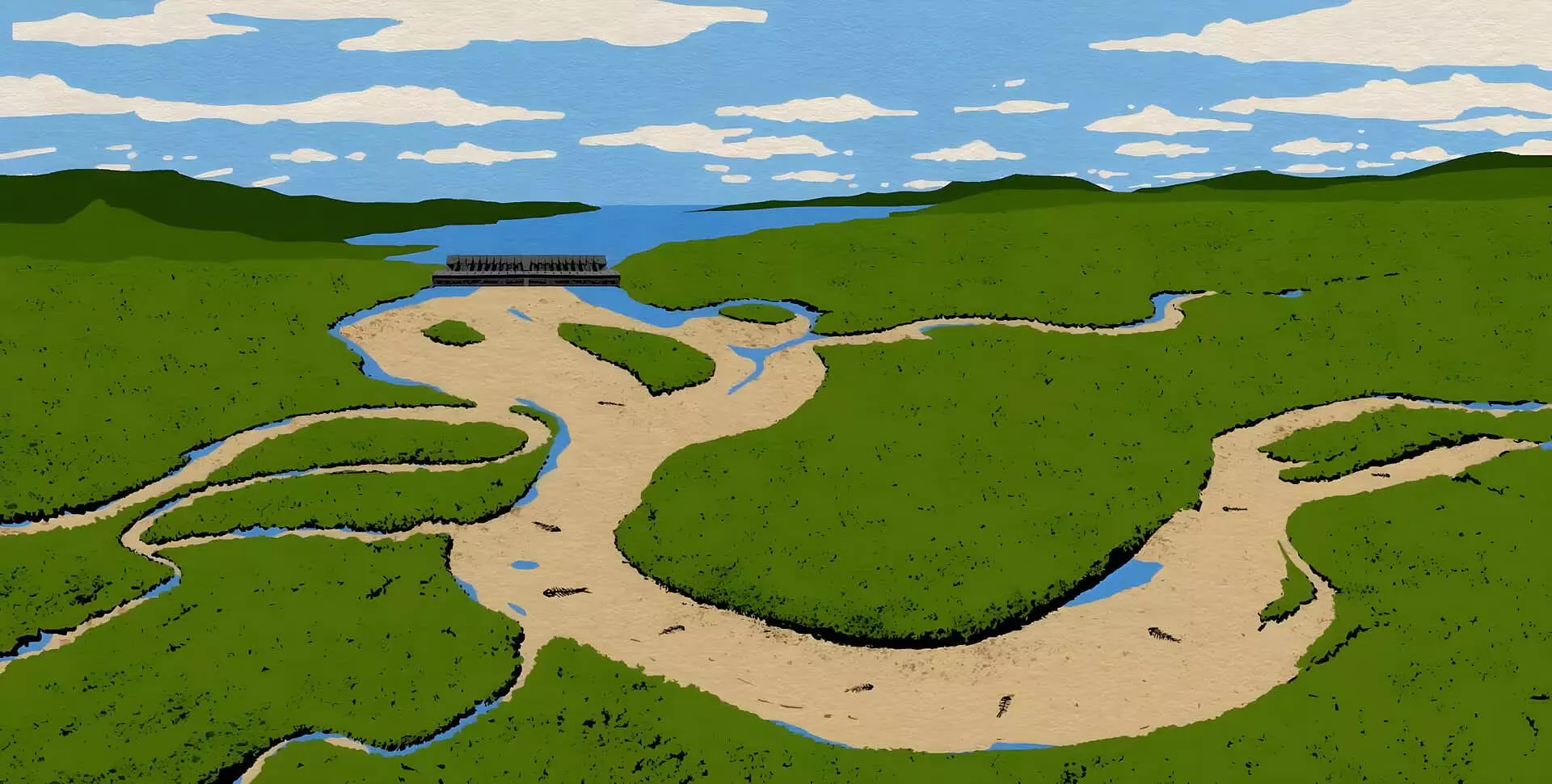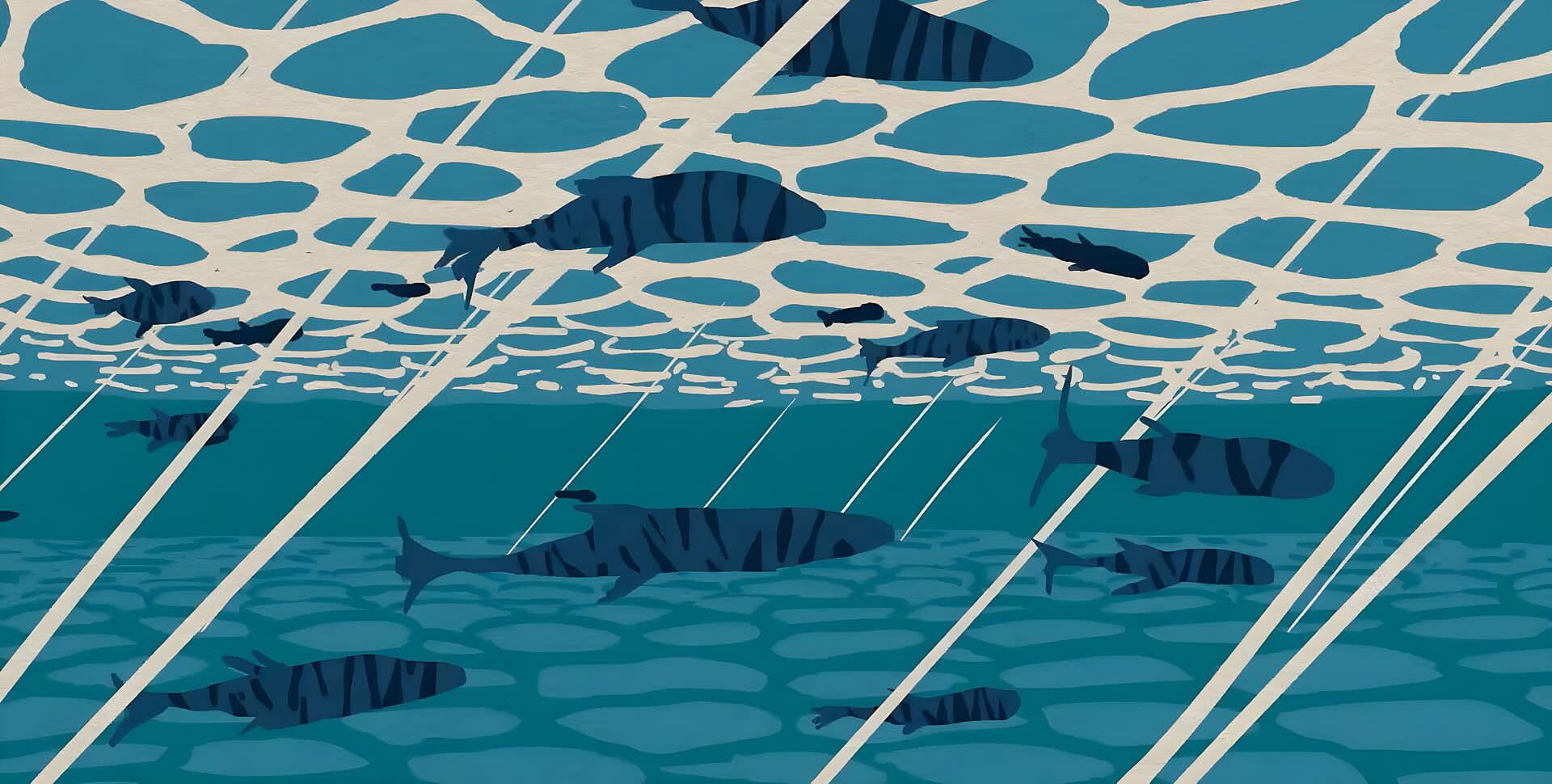It’s easier for us to protect the things we know and love. That is the premise of Piracema Hydrogram, an animation that is the most recent audiovisual, artistic, scientific, and political creation straight from the Volta Grande do Xingu region to the world. Right at the start, a globe of water and forests appears on screen, with the camera zooming in to show the course of the Xingu River. “When the water speaks, the fish listen. It’s a delicate conversation, and the fish know exactly when to swim up river, when to go to the piracema [spawning grounds for aquatic species],” says the deep voice of narrator Erik Vesch, while the camera dives to show the dancing fish in the water. SUMAÚMA was given exclusive access to the animation and is sharing it here first-hand to our readers and supporters.
Then the soundtrack drops, and the Pimental Dam, the Belo Monte hydroelectric plant’s main dam, appears on the screen. “If the water is confused, uneasy, obstructed, asking for help, this pain spreads and the fish don’t reproduce,” the narrator says. The realistic drawings go on to show dry eggs in the fish’s bellies or dead fish in dry areas, along with dead tracajás [a species similar to a turtle] and a lone Indigenous person walking along the dry bed of the Xingu River.
Everything in the animation, including the gendering of the word “peixas” in Portuguese to refer to female fish, comes from the knowledge, language, and political alliance of the communities suffering the adverse effects of the river’s sequestration by the Belo Monte Dam. Since 2014, Indigenous peoples and people from the traditional ribeirinho community have together been coordinating and carrying out Independent Environmental Territory Monitoring, measuring a variety of indicators on a daily basis – fish numbers and size, flood levels, fruit production, food sources, water quality – in the Volta Grande do Xingu region, the area suffering some of the worst impacts from 70% of the river’s waters being deviated by the power plant.
The animation illustrates for a Brazilian audience as well as for the Xingu’s own residents the fight for the piracema hydrogram, after which the video is named. The idea, developed based on close collaboration between Indigenous and ribeirinho researchers carrying out environmental monitoring and scientists from several Brazilian universities, was already shown in March of this year to technical staff at the Brazilian Institute of Environment and Renewable Natural Resources (Ibama). But it has yet to receive a response.
To recover at least some of the life disappearing from the region because of impacts from Belo Monte, the proposal is to implement a new water release schedule that is more closely aligned with the river’s natural flow. The narrator tells us that “the piracema hydrogram sets more appropriate water flow volumes and the times of year they should occur to guarantee the life cycles of the fish.” “It is essential that the river’s pulse be closer to its natural pulse,” ends the narration, written by Ana Paula Anderson.

In four minutes, the short film takes an educational look at how the Belo Monte Dam has kept female fish from reproducing. Photo: From the animated short Hidrograma das Piracemas/press photo
At the frontier between an artistic creation and a tool for mobilization, the animated short, directed by João Maia, of Cama Leão productions, is the second this same team has made about Volta Grande, which is Portuguese for “Big Bend.” Launched in 2018, the first animation, called Xingu, the river that beats in us, dealt with an earlier moment in the fight, when it was important to show Brazilian society how the Yudjá/Juruna people are connected to this territory and how diverting the water could spell death for ecosystems.
The first video traveled the world and was awarded at Anima Mundi, Latin America’s premier animation festival, in 2019. Today, the political alliance defending the region has grown, with various communities of ribeirinhos, a traditional forest community, having joined the Yudjá to expand monitoring. It was this mobilization that ensured that Ibama forced Norte Energia, which holds a concession to Belo Monte, to produce fresh data on water shortages and floods that failed to materialize at fish spawning grounds – or piracemas. And this data was used to put together the hydrogram proposal, the animation’s central theme.
The video uses rotoscoping, a type of digital drawing done over videos and photos that gives the end result a realistic feel. At the same time, it is able to convey the beauty of the Volta Grande region and of its residents and the drama of the disaster they have experienced since the Pimental Dam was closed in 2015. Illustrator Adams Carvalho worked on the animation as well as on the first award-winning short. The entire process took around one year to finish and involved staff from Instituto Socioambiental (ISA), scientists working with the Independent Environmental Territory Monitoring, and various residents in the region, especially the Yudjá Indigenous people. They recognized themselves in the scenes and saw the four-minute video as a tool in the fight.
“The short shows what we have been saying for so long. Everything is thoroughly explained. Sometimes, when I think that they aren’t understanding what I’m saying, I show them the animation from 2018. Now, with the new animation, we’ll have another instrument to fight for the piracema hydrogram,” says Bel Juruna, a resident of Muratu Village, born and raised in the Volta Grande region, who serves as one of her people’s main leaders. “We try to explain about the part of the river with diminished flow and people don’t always understand, but when they watch everything makes sense,” she says.

Around 70% of the waters in the Volta Grande do Xingu region were diverted by the dam. Photo:From the animated short Hidrograma das Piracemas/press photo
Bel, who has been a health worker in the village for ten years, is shown in the video in a scene that actually occurred, where she talked to other people living in the Volta Grande region about the work of monitoring the impacts from the lack of fish on people’s diets and health. A shortage of traditional food forces them to turn to industrialized alternatives, frozen chicken, encased meats, or processed meats. “There is a lot of high cholesterol now, fatty livers, high blood pressure. New people showing up with these problems. It’s because of the food,” she says.
One of Bel’s brothers, Josiel Juruna, is the general coordinator of Independent Environmental Territory Monitoring. He doesn’t appear in the video, but his work does. In February of this year, when the animation was almost ready, the team stopped everything to include a discovery he made of a fish nursery that became a tomb, with thousands of dead eggs in the dry ground of a piracema that should have been flooded. His hand, holding the dead eggs, is shown on screen, followed by a SUMAÚMA headline from exclusive reporting on the massacre.
It was an episode that showed not just Brazilian society, but the region’s residents as well, the extent to which Belo Monte represents the death of the future of the Volta Grande region. “When we came across that tragedy in the Zé Maria piracema, I immediately told the film’s director. No one had seen this happen in the Volta Grande region yet. It was a very sad, shocking situation for us. Those eggs were fish that would have grown up with our children and fed them. It’s so important that there be a record of this,” Josiel recalls.
Director João Maia explains that the animation for Piracema Hydrogram represents a specific type of audiovisual production that exists to fight for peoples and territories, and he defines it not as an original but as a collective work. “It’s a process with lots of involvement, lots of research, and that’s exhaustive too. Because that is what animation demands of us. It’s like building a large structure with teeny tiny bricks that take a long time to put in place. And the challenge is getting people to understand, even those foreign to the topic, to move them, and at the same time it has to be technically right, the Ibama team has to hear it,” he told SUMAÚMA.
The soundtrack plays a highly important role in understanding and in the emotional aspect. It contains a reinterpretation by Marlui Miranda, an artist from Ceará who records and shares the musical expressions of various Indigenous peoples in Brazil, of a song by the Yudjá people, as well as the song Awã Pãre, by Are Juruna, a young Yudjá man who lives along the Upper Xingu River, but who is shown at the end of the video playing his flute among the region’s rocky outcrops while on a visit to the Volta Grande region.
Thais Mantovanelli, an anthropologist with the ISA, which is supporting the environmental territory monitoring work, is the one who says that we only protect the things we know, that we love. “So we try to bring people into our canoe,” she says. “The animation goes into the computer, into the cell phones of the people who will learn about this story for the first time or that have already heard it and think that Belo Monte is a done deal. What is a done deal is the engagement of the Volta Grande do Xingu communities with the fight for life. The conditions for operating the plant, this is what does indeed need to be analyzed, because all of the conditions, all of the programs, up until now nothing has really worked to protect the ecosystems and people there. This has to be looked at with calm,” she says.
This is what the residents participating in monitoring are demanding. “Since this work started, they’ve said they didn’t want to monitor their own death, they wanted to understand what was happening to protect life. This is what the proposed piracema hydrogram represents,” says Thais. “It is with the pulse of the river that aquatic animals lay their eggs, offspring develop, fruit falls in the water, fish feed, Indigenous and ribeirinho peoples fish and live. The piracema hydrogram was developed by them in an unprecedented initiative, to show that synchronicity between the river and the forest sustains life. The decision needs to be made now: which proposal will be adopted?” the narrator asks. At the end a call to arms appears on screen: “Free the waters. Save Volta Grande do Xingu.” It will be up to Brazil’s society to mobilize. The solution is in Ibama’s hands.
Translation into Spanish: Meritxell Almarza
English translation: Sarah J. Johnson
Photography editing: Marcelo Aguilar, Mariana Greif and Pablo Albarenga
Page setup: Érica Saboya

A study done by Indigenous peoples, ribeirinhos and specialized academics, as shown in the animated film, shows the water flows appropriate for fish reproduction – which Norte Energia unfortunately does not follow. Photo: From the animated short Hidrograma das Piracemas/press photo





